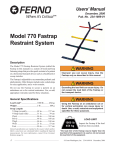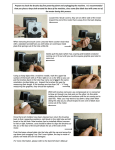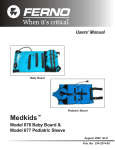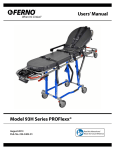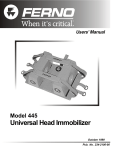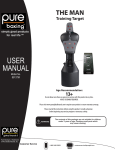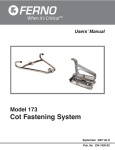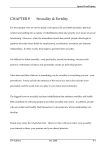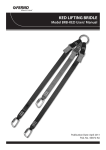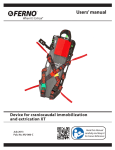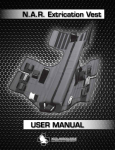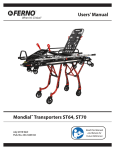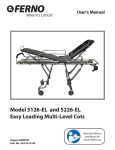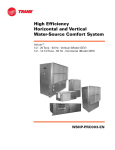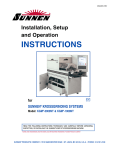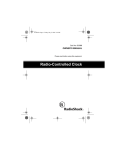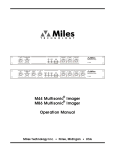Download KED Users` Manual
Transcript
Users’ Manual Model 125 KED April 2001 Pub. No. 234-1754-02 Model 125 KED Disclaimer This manual contains general instructions for the use, operation and care of this product. The instructions are not all-inclusive. Safe and proper use of this product is solely at the discretion of the user. Safety information is included as a service to the user. All other safety measures taken by the user should be within and under consideration of applicable regulations. It is recommended that training on the proper use of this product be provided before using this product in an actual situation. Retain this manual for future reference. Include it with the product in the event of transfer to new users. Additional free copies are available upon request from Customer Service. Proprietary Notice The information disclosed in this manual is the property of FernoWashington, Inc., Wilmington, Ohio, USA. Ferno-Washington, Inc. reserves all patent rights, proprietary design rights, manufacturing rights, reproduction use rights, and sales use rights thereto, and to any article disclosed therein except to the extent those rights are expressly granted to others or where not applicable to vendor proprietary parts. Instructional Material Provided with the KED: Model 125 KED Users’ Manual 234-1754 © Copyright Ferno-Washington, Inc. All Rights Reserved. Ferno-Washington, Inc. 70 Weil Way Wilmington, OH 45177-9371 U.S.A. Telephone (U.S.A. and Canada) ........... 800.733.3766 Telephone (Worldwide) ....................... 937-382-1451 Fax (United States) ............................... 937.382.1191 Fax (Outside U.S.A.) ........................... 937-382-6569 Internet.............................................. www.ferno.com 2 © Ferno-Washington, Inc. 234-1754-02 April 2001 Model 125 KED Contents TABLE OF CONTENTS Section Page 1 - Safety Information .................................................... 5 1.1 Warning ............................................................. 5 1.2 Important .......................................................... 5 1.3 Be Aware .......................................................... 5 1.4 Bloodborne Disease Notice ............................. 5 2 - Operator Skills and Training ................................... 6 2.1 Skills ................................................................. 6 2.2 Training ............................................................ 6 3 - About the KED ...................................................... 7-8 3.1 Model KED Description .................................. 7 3.2 General Specifications ..................................... 7 3.3 Components ..................................................... 8 4 - About the KED Features .................................... 9-14 4.1 Quick-Release Buckle ...................................... 9 4.2 Shortening the Securing Straps ........................ 9 4.3 Lengthening the Securing Straps ................... 10 4.4 Releasing the Securing Straps ....................... 10 4.5 Torso Straps .................................................... 11 4.6 Leg Straps ....................................................... 12 4.7 Adjusta-Pad .................................................... 13 4.8 Lifting Handles .............................................. 13 4.9 Head Straps .................................................... 14 Section Page 6 - Adapting the KED in Special Situations ......... 25-27 6.1 General Guidelines ......................................... 25 6.2 Adapting the KED for a Pregnant Patient ...... 25 6.3 Adapting the KED for a Pediatric Patient ...... 26 6.4 Adapting the KED for an Angulated Neck .... 26 6.5 Adapting the KED for Use With Monitoring Systems ....................................... 26 6.6 Adapting the KED for Use as a Splint ........... 27 6.7 Using the KED with an Anti-Shock Garment ..................................... 27 7 - Storing the KED ................................................ 28-31 7.1 Storing the KED Properly .............................. 28 8 - Maintaining the KED ............................................. 31 8.1 Maintenance Schedule ................................... 31 8.2 Cleaning and Disinfecting the KED .............. 31 8.3 Inspecting the KED ........................................ 31 9 - Limited Warranty ................................................... 32 10 - Customer Service .................................................. 32 Training Record ............................................................ 33 Maintenance Record .................................................... 34 5 - Using the KED ................................................... 15-24 5.1 Before Placing the KED in Service ............... 15 5.2 General Guidelines for Use ............................ 15 5.3 Applying the Cervical Collar ......................... 16 5.4 Removing the KED from the Carrying Case .......................................... 16 5.5 Placing the KED Behind the Patient .............. 17 5.6 Wrapping and Positioning the KED .............. 18 5.7 Fastening the Torso Straps ............................. 19 5.8 Applying the Leg Straps ................................. 20 5.9 Securing the Patient’s Head ........................... 21 5.10 Buckling the Top Strap and Making Final Strap Adjustments .............................. 22 5.11 Transferring the Patient to the Long Spine Board ................................. 23 © Ferno-Washington, Inc. 234-1754-02 April 2001 Notes .............................................................................. 35 3 Contents Model 125 KED Illustrations Components ...................................................................... 8 Figure 31 - Wrapping the Head Flaps with Figure 1 - Fastening the Buckle ....................................... 9 Padding in Place........................................ 21 Figure 2 - Unfastening the Buckle ................................... 9 Figure 32 - Head Straps Applied .................................... 21 Figure 3 - Removing Excess Slack from Strap ................ 9 Figure 33 - The KED, Applied ....................................... 22 Figure 4 - Feed and Pull Tightening Technique .............. 9 Figure 34 - Patient Pivoted with Back Figure 5 - Loosening a Buckled Strap ........................... 10 Figure 6 - Lengthening a Free Strap .............................. 10 Figure 7 - Releasing a Torso Strap from Its Fastener .... 10 Figure 8 - Torso Straps (As Folded for Storage) ........... 11 Figure 9 - Middle Strap Fastened .................................. 11 Figure 10 - Middle and Bottom Straps Fastened ........... 11 Figure 11 - Leg Strap Applied in Criss-Cross Configuration ............................................. 12 Toward Inside of Vehicle .......................... 23 Figure 35 - Lifting the Patient to Position the Long Spine Board ............................... 23 Figure 36 - Placing Patient and Long Spine Board on Ambulance Cot .................................... 24 Figure 37- Loosening Top (Green) Torso Strap for Patient Comfort .......................................... 24 Figure 38 - Positioning Torso Straps Figure 12 - Back View of Leg Straps Correctly Positioned Beneath Breasts/Above Abdomen ............ 25 Close to the Body Midline ......................... 12 Figure 39 - Two-Strap Configuration ............................ 25 Figure 13 - Positioning the Adjusta-Pad ........................ 13 Figure 40 - Three-Strap Configuration .......................... 25 Figure 14 - KED Lifting Handles .................................. 13 Figure 41 - Applying the KED to a Child ...................... 26 Figure 15-A and 15-B - Exposing Center Pad Rubber .. 14 Figure 42 - Applying the KED to an Angulated Neck .. 26 Figure 16 - Head Straps in Place ................................... 14 Figure 43 - Adapting the KED for Use with a Figure 17 - Applying the WizLoc™ Cervical Collar ..... 16 Figure 18 - Removing the KED From Its Carrying Case ...................................... 16 Figure 19 - Sliding the KED at an Angle ....................... 17 Monitoring System ................................... 26 Figure 44 - Stabilizing the Hip and/or Femur ............... 27 Figure 45 - Stabilizing the Pelvis ................................... 27 Figure 46 - Using the KED with an Figure 20 - Centering the KED ...................................... 17 Anti-Shock Garment ................................ 27 Figure 21-A and 21-B - Releasing a Leg Strap ............. 17 Figure 47 - Turning the Buckle Under ........................... 28 Figure 22- Wrapping the Torso Flaps Figure 48 - Making the First Fold .................................. 28 Around the Patient ..................................... 18 Figure 49 - Folding Accordion Style ............................. 28 Figure 23 - Moving the Patient Back into the KED ...... 18 Figure 50 - Securing the Strap ....................................... 28 Figure 24 - Releasing a Torso Strap ............................... 19 Figure 51 - Wrapping the Leg Straps ............................. 29 Figure 25 - Middle Strap Fastened ................................ 19 Figure 52 - Securing the Folded Strap Figure 26 - Middle and Bottom Straps Fastened ........... 19 Figure 27 - Passing a Leg Strap Beneath the Patient’s Leg ........................................ 20 Figure 28 - Back View of Leg Straps When in the Fastener ........................................... 29 Figure 53 - Positioning the Adjusta-Pad and Head Straps ........................................ 30 Figure 54 - Folding the Torso Flap ................................ 30 Properly Positioned .................................... 20 Figure 55 - Rolling the KED .......................................... 30 Figure 29 - Leg Straps in Criss-Cross Configuration .... 20 Figure 56 - Ready for the Carrying Case ....................... 30 Figure 30 - Placing the Padding ..................................... 21 Maintenance Schedule ................................................... 31 Lot Number Location ..................................................... 32 4 © Ferno-Washington, Inc. 234-1754-02 April 2001 Safety Information Model 125 KED 1 - SAFETY INFORMATION 1.1 Warning 1.2 Important The following warnings appear in this manual. Boxes like the one below emphasize important information. ! WARNING Untrained operators can cause injury or be injured. Permit only trained personnel to apply the KED. Important To prevent pressure on the groin when using the same-side configuration, correctly position the leg straps to lay straight down from their anchoring points on the KED. Improper use of the KED can cause injury. Use the KED only for the purpose described in this manual. Improper application of the KED can cause injury. Apply the KED only as described in this manual. An unattended patient can be injured. Stay with the patient at all times. An unrestrained patient can fall off the spine board or cot and be injured. Use restraints to secure the patient on the spine board and cot. Attaching other equipment or items to the KED can cause injury. Do not attach equipment or items of any kind to the KED. Improper maintenance can cause injury. Maintain the KED only as described in this manual. 1.3 Be Aware Boxes like the one below serve as reminders. Be Aware Positioning the patient as fully as possible against the KED minimizes the need for padding between the patient’s head and the KED. But be aware that some patients may not be able to sit fully back into the KED. 1.4 Bloodborne Disease Notice OSHA (Occupational Safety and Health Administration) requires employers to protect workers from workplace exposure to bloodborne diseases such as HIV-1 and hepatitis. To reduce the risk of exposure when using the KED, follow the disinfecting and cleaning instructions in this manual. For more information, visit www.osha.gov on the Internet or write to: U.S. Department of Labor, OSHA Office of Public Affairs, Room N-3647 200 Constitution Ave., NW Washington, DC 20210 © Ferno-Washington, Inc. 234-1754-02 April 2001 5 Operator Skills and Training Model 125 KED 2 - OPERATOR SKILLS AND TRAINING 2.1 Skills Operators using the KED need: 2.2 Training Trainees need to: a working knowledge of emergency patienthandling procedures. follow a training program designed by their training officer. the ability to assist the patient. read this manual. a complete understanding of the procedures described in this manual. practice with the KED before using it in regular service. be tested on their understanding of the KED. record their training information. ! WARNING Untrained operators can cause injury or be injured. Permit only trained personnel to apply the KED. 6 © Ferno-Washington, Inc. 234-1754-02 April 2001 Model 125 KED About the KED 3 - ABOUT THE KED 3.1 Model 125 KED Description 3.2 General Specifications The Model 125 KED (Kendrick Extrication Device, referred to as the KED in this manual) is an emergency patient-handling device designed to aid in the immobilization and short transfer movement of patients with suspected spinal/cervical injuries or fracture. Length Opened Flat ....................................... 33 in (83 cm) Rolled, in Case .................................. 35 in (90 cm) Width Opened Flat ....................................... 32 in (80 cm) Rolled, in Case .................................. 11 in (27 cm) Thickness Opened Flat ........................................... 1 in (3 cm) Rolled, in Case .................................... 6 in (14 cm) Weight* .......................................... 7 lb 11 oz (3 kg) Load Limit ....................................... 500 lb (227 kg) The KED is designed for use by a minimum of two trained operators. Additional help may be preferred or needed. KED features include: • Color-coded, sewn-in securing straps • Wraparound head flaps • Wraparound torso flaps • Head straps • Adjusta-Pad™ for padding • Integrated carrying handles • Carrying case • Radiographic translucence ! WARNING Improper use of the KED can cause injury. Use the KED only for the purpose described in this manual. * Weight includes restraints, pad, head straps, and carrying case. General specifications are rounded to the nearest whole number. Metric conversions are calculated before rounding the English measurements. For detailed specifications, contact Ferno Customer Service (page 32) or your Ferno distributor. Ferno reserves the right to change specifications without notice. LOAD LIMIT 500 lb 227 kg Inspect the KED if the Load Limit has been exceeded (see Inspecting the KED, Page 31). © Ferno-Washington, Inc. 234-1754-02 April 2001 7 Model 125 KED About the KED 3.3 Components (Outside View with Straps in Storage Configuration) Center Lifting Handle (1) Hook-and-Loop Fastening Strips (10) Torso Strap Buckle (3) Leg Strap (2) Head Flap (2) Side Lifting Handle (2) Torso Straps (3) Torso Flap (2) Leg Strap Buckle (2) Head Strap (2) Adjusta-Pad Carrying Case (not to scale) 8 © Ferno-Washington, Inc. 234-1754-02 April 2001 About the KED Features Model 125 KED 4 - ABOUT THE KED FEATURES 4.1 Quick-Release Buckles KED buckles are snap-lock and quick-release. Torsostrap buckles are black. Leg-strap buckles are white. FASTENING THE BUCKLES Slide Receiver Figure 1 Fastening the Buckle To fasten a buckle, push the slide into the receiver until it locks into place (Figure 1). A distinctive “click” signals that the slide is properly placed in the receiver. To unfasten a buckle, press the slide tabs to release the slide, then pull the slide out of the receiver slot (Figure 2). Figure 2 Unfastening the Buckle 4.2 Shortening the Securing Straps Buckled torso and leg straps are shortened in two stages, first removing excess slack and then snugging or tightening the straps. Use the techniques described below to shorten the straps. REMOVING EXCESS SLACK When a torso strap is released from its storage position there is a large amount of slack. After fastening the buckle, quickly remove most of the slack by turning the buckle up, away from the KED, with one hand while you pull the hemmed end of the strap with the other hand (Figure 3). Shorten the strap only until you feel the slightest tension. Figure 3 Removing Excess Slack from the Strap SNUGGING OR TIGHTENING THE STRAP To prevent twisting or jostling the patient’s torso when snugging or tightening the strap, use the feed-and-pull tightening technique below: 1. Grasp the portion of the strap that lays across the patient’s torso and create a little slack in the strap (Figure 4). 2. Feed the slack into the buckle with one hand and pull it through the buckle with the other hand (Figure 4). Repeat until the strap is snug or tight. © Ferno-Washington, Inc. 234-1754-02 April 2001 Figure 4 - Feed-and-Pull Tightening Technique 9 About the KED Features Model 125 KED 4.3 Securing Straps - Lengthening The technique used for lengthening a strap depends on whether the strap has been buckled. LENGTHENING A BUCKLED STRAP To loosen or lengthen a buckled strap, feed excess strap into the buckle with one hand as you raise the buckle at an angle to the KED with the other hand (Figure 5). LENGTHENING A FREE STRAP To lengthen a free strap, hold the slide at an angle to the strap with one hand and pull the strap backward through the buckle slide with the other hand (Figure 6). Figure 5 - Loosening a Buckled Strap 4.4 Securing Straps - Releasing If torso and leg straps have been properly configured for storage, they can be released quickly and without tangles when they are needed. For instructions on configuring the straps for storage, see Storing the KED, pages 28 and 29 . TORSO STRAPS Simply grasp the sides of the buckle (Figure 7) and firmly pull it from the fastener. LEG STRAPS If you are going to use the leg straps, leave them in the storage configuration until the KED has been placed behind the patient but not wrapped and fastened. Free the straps from the hook-and-loop fastener, slide them from behind the patient, and lay them with the buckles within your reach. Figure 6 - Lengthening a Free Strap Hook-andLoop Fastener If you are not going to use the leg straps, leave them attached in the storage configuration, where they will not interfere with applying the KED. Figure 7 - Releasing a Torso Strap From Its Fastener 10 © Ferno-Washington, Inc. 234-1754-02 April 2001 Model 125 KED About the KED Features 4.5 Torso Straps The KED is constructed with three torso straps: top, middle, and lower. The straps are color coded for easy matching of left and right pieces (Figure 8). Torso Straps When wrapping the KED torso flaps around the patient, fasten the middle (yellow) strap first, then the bottom (red) strap. Do not fasten the top (green) strap until just before you are ready to transfer the patient to a long spine board. THE MIDDLE STRAP The middle (yellow) strap is the first strap to be fastened (Figure 9). Figure 8 -Torso Straps (As Folded for Storage) When fastening the strap initially, snug it until there is space for 2 or 3 fingers laid flat between the strap and the patient’s torso. You will tighten the strap just before transferring the patient to a spine board. The middle strap evenly secures the greatest possible area of the KED, providing the greatest patient stability while you finish applying the KED. If the rescue situation or the patient’s condition requires that you remove the patient from the vehicle sooner than anticipated, the stability provided by the KED with only the middle strap fastened, and properly tightened, may be preferable to using no supporting equipment. Follow your medical advisor’s guidelines on this issue. THE BOTTOM STRAP Figure 9 - Middle Strap Fastened The bottom (red) strap is the second strap fastened (Figure 10). When fastening the strap initially, snug it until there is space for 2 or 3 fingers laid flat between the strap and the patient’s torso. You will tighten the strap just before transferring the patient to a spine board. THE TOP STRAP Do not fasten the top (green) strap at this time. Leave the top strap unfastened until you are ready to transfer the patient to the long spine board. This allows the patient to breathe more freely while you finish applying the KED. © Ferno-Washington, Inc. 234-1754-02 April 2001 Figure 10 - Middle and Bottom Straps Fastened 11 About the KED Features Model 125 KED 4.6 Leg Straps The leg straps secure the pelvis to the lower portion of the KED to stabilize the lower lumbar area. Follow your medical advisor’s guidelines concerning the use of leg straps. The KED leg straps can be fastened in a “criss-cross” configuration or a “same-side” configuration, depending on the patient’s condition. The leg straps are most commonly used “criss-cross” style (Figure 11). For this configuration, pass the straps under the patient’s legs and buckle the left strap at the right side of the KED and the right strap at the left side of the KED (see Applying the Leg Straps, Page 20, for complete instructions). Figure 11 - Leg Strap Applied In “Criss-Cross” Configuration If groin injury is suspected, you can use the straps in the “same-side” configuration to reduce pressure on the groin area. Pass the straps under the legs and buckle the left strap at the left side of the KED and the right strap at the right side of the KED. Whether using the “criss-cross” or “same-side” configuration, you must position the straps as close as possible to the body’s midline. When buckled straps are correctly positioned, they run straight down from their anchoring points on back of the KED (Figure 12) before passing beneath the buttocks. Note: Positioning the straps correctly for the “sameside” configuration requires a more focused effort because the tendency during this application is to place the straps away from the midline. Leg Strap Anchoring Points Midline Figure 12 - Back View of Leg Straps When Correctly Positioned Close to the Body Midline Important To prevent pressure on the groin when using the same-side configuration, take care to correctly position the leg straps close to the body midline. 12 © Ferno-Washington, Inc. 234-1754-02 April 2001 Model 125 KED About the KED Features 4.7 Adjusta-Pad The foam-filled Adjusta-Pad can be used to fill the gap that may exist between the KED and any of these areas: head, cervical collar (or neck, if no collar is used), shoulders. The patient’s medical condition, body structure, and head shape determine the need for padding. Most patients, when properly positioned in the KED, will not need padding but when you do use it, follow your medical advisor’s guidelines. If you need to apply the Adjusta-Pad: 1. Determine whether to use the pad single thickness or folded. 2. Slide the pad between the KED and the patient (Figure 13). Depending on the patient’s injuries, body structure, and head shape, the pad may be positioned behind the head only, behind the head and neck area, or behind head, neck area, and the tops of the shoulders. Figure 13 - Positioning the Adjusta-Pad Always take care to pad without hyperextending or flexing the patient’s neck. 3. Secure the patient’s head with the head straps (see Head Straps, page 14). Note: The Adjusta-Pad may also be used as a splint pad. Lifting Handles 4.8 Lifting Handles The KED is constructed with three lifting handles (Figure 14). Use the handles when adjusting the KED’s vertical position on the patient and during extrication. The top lift handle serves as an extension of the leg straps and offers a firm hold for vertical lift or horizontal pull to get the patient in position to extricate. Figure 14 - KED Lifting Handles During extrication, the handles provide a firm hold on the patient/KED as a single unit, minimizing chances of losing control or dropping the patient during extrication. The two side handles provide the firmest holds for extrication. © Ferno-Washington, Inc. 234-1754-02 April 2001 13 Model 125 KED About the KED Features 4.9 Head Straps Two identical head straps are provided to secure the KED head flaps in place. They can also be used to secure the KED when using it as a splint. 15-A APPLYING THE UPPER STRAP 1. Grasp the strap with both hands (Figure 15-A) and turn the center pad fully inside-out, exposing the rubber (Figure 15-B). 2. Center the pad at the patient’s eyebrows with the rubber against the skin. Position the strap ends at a downward angle and secure them to the fastening strips on the KED head flaps (Figure 16). 15-B Note: Placing the strap ends at a downward angle minimizes the chance that the strap can slip upward on the forehead. APPLYING THE LOWER STRAP Figures 15-A and 15-B - Exposing the Center Pad Rubber Two methods for applying the lower strap are provided below. There are alternate methods. Use and secure the strap according to your medical director’s guidelines. One method for applying the lower strap when using a rigid cervical collar is shown in Figure 16: 1. Place the strap against a rigid area beneath the “chin” of the cervical collar. 2. Position the strap ends horizontally, or just above the horizontal, and secure them to the fastening strips on the head flaps. A method for applying the lower strap to the patient’s chin area, with or without a cervical collar, would be: 1. Grasp the strap with both hands and turn the center pad fully inside-out, exposing the rubber. Figure 16 - Head Straps in Place 2. Place the strap over the patient’s chin or over the cervical collar chin area. 3. Position the strap ends horizontally and secure them to the fastening strips on the head flaps. Make sure the strap placement does not prevent the patient from opening his/her mouth. 14 © Ferno-Washington, Inc. 234-1754-02 April 2001 Model 125 KED Using the KED 5 - USING THE KED 5.1 Before Placing the KED in Service Personnel who will work with the KED need to read this manual and practice using the KED before placing it in service. Confirm that the KED operates properly. Carry out an inspection, following instructions in Inspecting the KED, page 31. 5.2 General Guidelines for Use • This manual illustrates use of the KED in an ideal setting. Other, and sometimes unusual, settings and circumstances will occur in the field and the KED can be adapted to many of them. It is the responsibility of qualified Emergency Medical Service personnel to assess the patient’s condition and determine the proper equipment and procedures to use. • Follow your medical director’s guidelines when using the KED. • Optimum use of the KED includes one operator manually stabilizing the patient’s head and neck, two operators applying the KED, and a fourth operator managing the long spine board. ! WARNING Improper application of the KED can cause injury. Apply the KED only as described in this manual. ! WARNING An unattended patient can be injured. Stay with the patient at all times. In situations where there are only two or three trained operators available, one operator manually stabilizes the head and neck while the other(s) applies the KED. • Follow standard emergency patient-handling procedures when using the KED. • Maintain manual stabilization of the patient’s head and neck until the patient is properly secured on a long spine board. • After applying the KED and transferring the patient to the spine board, secure the patient to the spine board with restraints. • Stay with the patient at all times. © Ferno-Washington, Inc. 234-1754-02 April 2001 15 Using the KED Model 125 KED 5.3 Applying the Cervical Collar Apply the cervical collar according to local protocols and the manufacturer’s instructions. Maintain manual stabilization of the patient’s head and neck until the patient is properly secured on a long spine board. In Figure 17, one operator holds the patient’s head and neck in neutral alignment while the other operator applies Ferno’s WizLoc cervical collar. 5.4 Removing the KED from the Carrying Case Figure 17 - Applying the WizLoc® Cervical Collar The KED carrying case is designed for quick removal of the KED, as follows: 1. Stand the carrying case containing the KED on end with the open end of the case facing upward. Where the case meets the ground, there will be a left and right “dog ear” (Figure 18). 2. Place your foot on one of the “dog ears” to hold the case in place while you pull the KED out of the case (Figure 18) 3. Unroll the KED and lay the Adjusta-Pad and head straps aside. “Dog Ear” Figure 18 - Removing the KED From Its Carrying Case 16 © Ferno-Washington, Inc. 234-1754-02 April 2001 Model 125 KED Using the KED 5.5 Placing the KED Behind the Patient The instructions below allow operators to use the KED design features to their best advantage. 1. Check behind the patient for articles (wallet, belt, etc.) that could interfere with sliding the KED between the patient and the vehicle seat. 2. With the buckles toward the seat, grasp the KED at the top of the head flap and the top corner of the torso flap closest to the patient. 3. Tilt the KED at about a 45-degree angle and slide it behind the patient (Figure 19). Note: Use the KED’s vertical rigidity as an aid when sliding the KED behind the patient. Tilting the KED at a 45-degree angle provides a rigid leading edge to slip between the patient and seat, prevents the KED from rolling up, and allows the KED to clear the vehicle roofline. Figure 19 - Sliding the KED at an Angle 4. The operator and assisting operator(s) work the KED down between the patient and the back of the seat and then into the vertical position (Figure 20). Work the KED far enough down to clear the vehicle roofline and be positioned behind the patient’s head when the KED is tipped to the vertical. Note: The third operator may move the patient forward just enough (i.e., a hand’s thickness) to reduce friction so the KED slides smoothly between the patient and seat. To avoid jostling the patient’s head, coordinate this effort with the operator stabilizing the head. Figure 20 - Centering the KED While the KED is moved to the vertical the operator holding the patient’s head in alignment lifts his/her elbow slightly, providing clearance for the KED and taking care not to move the patient’s head. 5. Use the lift handles to center the KED behind the patient. 6. If you are going to use the leg straps, remove them from the fastening strips at the top of the KED (Figure 21-A). Slide them clear of the KED and lay them within reach (Figure 21-B). © Ferno-Washington, Inc. 234-1754-02 April 2001 Figure 21-A Figure 21-B Releasing a Leg Strap 17 Using the KED Model 125 KED 5.6 Wrapping and Positioning the KED 1. Wrap both torso flaps around the patient’s torso, lifting the patient’s arms only as much as needed to slide the flaps beneath them. The top of the flaps should be just below the patient’s armpits (Figure 22). 2. Use the lift handles to raise and adjust the KED until the top edges of the torso flaps press firmly into the armpit area. You can also use the lift handles to keep the KED in place until the straps can be buckled. If using three operators, the two side operators lift the KED with the side straps. Important Figure 22 -Wrapping the Torso Flaps Around the Patient It is important to pull the KED up snugly under the armpits to make sure the patient’s weight is suspended. This will reduce the possibility of the patient slipping downward later when he/ she is lifted. 3. Before beginning to fasten the straps, make sure the patient is sitting back against the KED as fully as his/her body structure and condition allow. To check and adjust the patient’s position, the operator behind the patient holds the patient’s head in alignment while a side operator gently presses on the patient’s chest area just below the cervical collar (Figure 23). Figure 23 - Moving the Patient Back Into the KED Be Aware Positioning the patient as fully as possible against the KED minimizes the need for padding between the patient’s head and the KED. But be aware that some patients may not be able to sit fully back into the KED. 18 © Ferno-Washington, Inc. 234-1754-02 April 2001 Using the KED Model 125 KED 5.7 Fastening the Torso Straps After the KED is wrapped and properly positioned under the armpits, fasten the middle strap and then the bottom strap. Do not fasten the top (green) strap at this time. Hook-andLoop Fastener To fasten the torso straps: 1. Remove the middle (yellow) strap from its holder by grasping the sides of the buckle and pulling the strap out of the holder (Figure 24). 2. Fasten the middle strap buckle (Figure 25). 3. Remove the bottom (red) strap from its holder and fasten the buckle (Figure 26). Figure 24 - Releasing a Torso Strap 4. Use the feed-and-pull tightening technique to snug both straps, leaving space for two or three fingers laid flat between the strap and the patient’s chest. You will fasten the top strap and tighten all other straps just before transferring the patient to a long spine board and the ambulance cot. A MEMORY AID Many EMTs remember the order for fastening straps by repeating this phrase: Figure 25 - Middle Strap Fastened “Money Buys Lots of Hot Toys.” Money= Middle Strap Buys = Bottom Strap Lots of = Leg Straps Hot = Head Straps Toys = Top Strap Figure 26 - Middle and Bottom Straps Fastened © Ferno-Washington, Inc. 234-1754-02 April 2001 19 Using the KED Model 125 KED 5.8 Applying the Leg Straps To apply the leg straps: 1. Pass the leg straps between the leg and car seat (make use of a gap if there is one). 2. Using both hands, “see-saw” one strap into position under the patient’s leg and buttock (Figure 27). Reach behind the patient and make sure the strap lays straight downward from its anchor point on the KED, as close as possible to the body midline (Figure 28). Figure 27 - Placing a Leg Strap Beneath the Patient’s Leg 3. Repeat steps 1 and 2 with the other leg strap. 4. If you are using the “criss-cross” configuration, cross the straps at the groin and buckle the straps opposite their sides of origin (Figure 29). Leg Strap Anchoring Points If you are using the “same-side” configuration, do not cross the straps at the groin. Buckle them on their sides of origin. 5. Snug both straps using the feed-and-pull tightening method (see Snugging or Tightening the Strap, page 9). Leave space for two or three fingers laid flat between the strap and the patient’s leg. You will tighten the leg straps just before transferring the patient to the long spine board. Midline Figure 28 - Back View of Leg Straps When Properly Positioned Be Aware For suspected groin injury, the leg straps can be used in the “same-side” configuration or not used at all. Always follow your medical advisor’s recommendations for the use of leg straps. Figure 29 - Leg Straps in the “Criss-Cross” Configuration 20 © Ferno-Washington, Inc. 234-1754-02 April 2001 Model 125 KED Using the KED 5.9 Securing the Patient’s Head APPLYING PADDING Be Aware The patient’s medical condition, body structure, and head shape determine the need for padding. Follow your medical advisor’s guidelines for the use of padding. 1. Make sure the patient is still properly positioned against the KED. Adjust if necessary. Figure 30 - Placing the Padding 2. If there is a gap between the KED and the patient’s head, the cervical collar, or the patient’s shoulders, fill the gap with the Adjusta-Pad or rolled towels (Figure 30) taking care not to hyperextend or flex the patient’s neck. (The Adjusta-Pad can be folded if additional thickness is needed.) APPLYING THE HEAD FLAPS One operator will hold the head and head flaps in place while another operator applies the head straps to secure and hold the patient’s head against the KED and/or padding. 1. Wrap the head flaps around the patient’s head (Figure 31). 2. Grasp a head strap with both hands and turn the center pad fully inside-out so the rubber will be against the patient’s forehead (see Head Straps, page 14). Figure 31 - Wrapping the Head Flaps with Padding in Place 3. Position the strap at the patient’s eyebrows and secure the strap to the head flap fastening strips at a downward angle (Figure 32). The angled placement minimizes the chance that the strap can slide upward on the forehead. 4. Place the second strap under or on the chin area of the cervical collar and position the strap ends as horizontally as possible. Secure the strap ends to the fastening strips on the head flaps (Figure 32). Take care not to apply the strap so snugly that the patient cannot open his/her mouth. For additional information, see Head Straps, page 14. Figure 32 - Head Straps Applied © Ferno-Washington, Inc. 234-1754-02 April 2001 21 Using the KED Model 125 KED 5.10 Buckling the Top Strap and Making Final Strap Adjustments When the long spine board and ambulance cot are prepared and waiting, it is time to buckle the top strap and make final adjustments to the other straps. The purpose of the adjustments is to make sure the KED is firmly in place from the lower spine to the head, and is positioned high up under the armpits to prevent movement during extrication. Finish applying the KED as follows: 1. Remove the top (green) strap from its holder and buckle it. Tighten the strap to the chest using the feed-and-pull technique (see Snugging or Tightening the Strap, page 9). 2. Check and tighten the middle (yellow) strap. 3. Check and tighten the bottom (red) strap. Figure 33 - The KED, Applied 4. Check and tighten the leg straps. The properly applied KED will look as illustrated in Figure 33. 22 © Ferno-Washington, Inc. 234-1754-02 April 2001 Model 125 KED Using the KED 5.11 Transferring the Patient to the Long Spine Board The technique described below for transferring the patient to the long spine board involves pivoting the patient with his/her back toward the midline of the vehicle. In many situations, this may be the most effective technique for preventing lower spine torque. Alternative techniques have been developed and are in use. Follow your medical director’s guidelines when choosing a technique. GENERAL GUIDELINES • The two operators pivoting and lifting the patient work from the same side of the vehicle. • Pivot the patient so his/her back is toward the midline (inside) of the vehicle. Be Aware Make sure to maintain the patient’s body angle and a straight midline as you pivot the patient to position his/her back toward the inside of the vehicle. Figure 34- Patient Pivoted with Back Toward Inside of Vehicle TRANSFERRING THE PATIENT TO THE LONG SPINE BOARD 1. Two operators grasp the side lift handles of the KED and pivot/tilt/lift the patient until his/her back is toward the inside of the vehicle (Figure 34). 2. Grasping the side handles of the KED and holding the patient under the knees, lift the knees enough to allow a third operator to slide the long spine board between the patient and the seat (Figure 35). Then lower the patient onto the spine board. Note: Slide the head-end edge of the spine board as close as possible to the far side of the seat so the patient will become properly positioned on the board when you lift the knees. Continued on Next Page © Ferno-Washington, Inc. 234-1754-02 April 2001 Figure 35 - Lifting the Patient To Position the Long Spine Board 23 Model 125 KED Using the KED 3. Lift the spine board and patient out of the vehicle and place them on the ambulance cot (Figure 36). 4. Immediately loosen the top (green) torso strap (Figure 37) to allow the patient more chest expansion. Note: Keeping the remaining straps tightened provides stability for the patient during the starts, stops, and corners of the ambulance ride to the hospital. 5. Tighten leg straps if necessary. Properly applied leg straps will loosen when the patient is placed supine on the spine board. 6. Apply a head immobilizer such as the Ferno Model 445. 7. Secure the patient on the spine board with the spine board restraints. 8. Secure the spine board on the cot with the cot restraints. ! WARNING An unrestrained patient can fall off the spine board or cot and be injured. Use restraints to secure the patient on the spine board and the cot. Figure 36 - Placing Patient and Long Spine Board on Ambulance Cot Figure 37 - Loosening Top (Green) Torso Strap for Patient Comfort 24 © Ferno-Washington, Inc. 234-1754-02 April 2001 Model 125 KED Special Situations 6 - ADAPTING THE KED IN SPECIAL SITUATIONS 6.1 General Guidelines When necessary, the KED can be adapted for use in special situations and circumstances. Some possible adaptions are presented in this section. Follow your medical director’s guidelines for adapting the KED. ! USING TWO STRAPS Fasten the bottom strap in the middle buckle and the middle strap in the bottom buckle (Figure 39). WARNING Attaching other equipment or items to the KED can cause injury. Do not attach equipment or items of any kind to the KED. 6.2 Adapting the KED for a Pregnant Patient When applying the KED to a pregnant patient, fold two slats inward on each torso flap to leave the abdomen exposed. Strap configuration will depend on the patient’s abdomen and breast size. Generally, straps can be positioned to lay beneath the breasts but above the abdomen (Figure 38). Two possible configurations are described in this subsection. Figure 39 - Two-Strap Configuration USING ALL THREE STRAPS Fasten the middle strap in its own buckle. Fasten the bottom strap in the top buckle. Fasten the top strap in the bottom buckle (Figure 40). Figure 38 - Positioning Torso Straps Beneath Breasts/Above Abdomen © Ferno-Washington, Inc. 234-1754-02 April 2001 Figure 40 - Three-Strap Configuration 25 Special Situations Model 125 KED 6.3 Adapting the KED for a Pediatric Patient The patient’s size and condition determine how the KED can be adapted for a child. In this example of one possible method, the child’s legs are longer than the KED so the KED and child are placed on a long spine board. A folded blanket is placed on the child so the torso flaps can be wrapped and fastened normally (Figure 41). Figure 41 - Applying the KED to a Child 6.4 Adapting KED for an Angulated Neck When it is not desirable to straighten the patient’s neck, fold the head flaps inward. Position a rolled towel as needed, then place a head strap across the patient’s forehead and secure the strap to the KED fastening strips (Figure 42). Figure 42 - Applying the KED to an Angulated Neck 6.5 Adapting the KED for Use With Monitoring Systems Folding two slats of each torso flap inward provides more chest exposure when needed. Loosening two of the three chest straps allows defibrillation without losing immobility (Figure 43). Figure 43- Adapting the KED for Use with a Monitoring System 26 © Ferno-Washington, Inc. 234-1754-02 April 2001 Model 125 KED Special Situations 6.6 Adapting the KED for Use As a Splint The KED can be used as a splint for pelvic stabilization and hip and/or femur stabilization. Two possible methods of adaptation are shown here. HIP AND/OR FEMUR STABILIZATION The KED and patient are placed on a long spine board with the head portion of the KED toward the foot end of the board. The torso portion of the is KED positioned a little above the waist and centered (Figure 44). The torso flaps are secured around the patient and the head flaps are wrapped around the patient’s injured leg and secured with the KED head straps (Figure 44). Figure 44 - Stabilizing the Hip and/or Femur PELVIC STABILIZATION The KED and patient are placed on a long spine board with the head portion of the KED toward the foot end of the board. The torso portion of the is KED positioned a little above the waist and centered. The torso flaps are secured around the patient’s pelvic area and the head flaps are wrapped around both the patient’s legs and secured with the KED head straps (Figure 45). Figure 45 - Stabilizing the Pelvis 6.7 Using the KED With an Anti-Shock Garment The KED will not interfere with, or limit the use of, a pneumatic anti-shock garment (Figure 46). Figure 46 - Using the KED with an Anti-Shock Garment © Ferno-Washington, Inc. 234-1754-02 April 2001 27 Storing the KED Model 125 KED 7 - STORING THE KED 7.1 Storing the KED If you properly prepare the KED before placing it in its carrying case you will be able to unpack and use it quickly and smoothly. TORSO STRAPS Fold each torso strap accordion fashion and secure it in its hook-and-loop fastener as follows: Figure 47 - Turning the Buckle Under 1. Lengthen the strap until only three or four fingerwidths of webbing have not passed backward through the buckle slide. 2. Turn the buckle under, flush against the webbing (Figure 47) 3. Make the first fold beneath the buckle (Figure 48) and continue folding the strap accordion fashion (Figure 49). Figure 48 - Making the First Fold 4. When all the webbing is folded, secure it in the hook-and-loop fastener (Figure 50). Make sure to position the folded strap so the fastening strips wrap around it at the location of the buckle release tabs. This will enable you to pull the strap free without tangles, and have the buckle in your hand, in a single motion. Figure 49 - Folding Accordion Style Figure 50 - Securing the Strap 28 © Ferno-Washington, Inc. 234-1754-02 April 2001 Model 125 KED Storing the KED LEG STRAPS Storing the leg straps as described here will keep them out of the way while sliding the KED between the patient and the vehicle seat, yet readily available when you want to use them. Leave the leg straps in their stored position in situations where you choose not to use them. Store both leg straps as follows: 1. Lengthen the leg strap until about six inches of webbing have not passed backward through the buckle slide. 2. Beginning at the point where the strap is attached to the KED, fold the strap down around the bottom edge of the KED then up and around the inside of the KED (Figure 51). 3. Turn the buckle under to rest flush against the webbing and secure the strap in place by pressing its hook-and-loop fastening strip against a fastening strip on the outside of the KED (Figure 52) Figure 51 - Wrapping the Leg Straps Figure 52 - Securing the Folded Strap in the Fastener © Ferno-Washington, Inc. 234-1754-02 April 2001 29 Storing the KED Model 125 KED ADJUSTA-PAD Lay the KED flat with the buckles facing upward. Place the Adjusta-Pad on the center of the KED, with one end of the pad at the bottom edge of the KED (Figure 53). HEAD STRAPS Press one end of each strap against the hook-and-loop fastening strips on the head area of the KED and lay the straps parallel with the Adjusta-Pad. Figure 54 - Folding the Torso Flap Figure 55 - Rolling the KED Figure 53 - Positioning the Adjusta-Pad And Head Straps TORSO FLAPS 1. Fold the torso flap over the Adjusta-Pad, tucking the edge of the flap over the edge of the pad (Figure 54). 2. Roll the folded portion of the KED over the remaining torso flap (Figure 55) until the center portion of the inside of the KED is upward (Figure 56). Figure 56 - Ready for the Carrying Case 3. Grasp the KED to keep it rolled and slide it into the carrying case. 30 © Ferno-Washington, Inc. 234-1754-02 April 2001 Model 125 KED Maintaining the KED 8 - MAINTAINING THE KED 8.1 Maintenance Schedule Disinfecting (this page) Each Month As Needed Each Use The KED requires regular maintenance. Set up and follow a maintenance schedule. The following chart represents minimum maintenance. • Cleaning (this page) • Inspecting (this page) • • When using maintenance products, follow the manufacturers’ directions and read the manufacturers’ material safety data sheets. 4. To disinfect, apply a solution of 2% to 5% chlorine bleach and water. 5. Rinse all pieces with warm water. 6. Allow all pieces to dry completely before returning them to the carrying case. Note: Drying time for the KED can vary from 2 to 36 hours, depending on temperature, humidity, and on how long the KED was exposed to water during use or during disinfecting and cleaning. (Moisture can be absorbed through the sewing holes, wetting the battens inside the KED). Important Storing a damp or wet KED in its carrying case will encourage the growth of mold. Do not return the KED to its carrying case until it is thoroughly dry. Contact Ferno Customer Service to order Ferno disinfectants and cleaners (page 32). ! WARNING Improper maintenance can cause injury. Maintain the KED only as described in this manual. 8.2 Cleaning and Disinfecting the KED 8.3 Inspecting the KED Are all components present? Is all stitching secure? Are vertical battens (inside KED) solid and unbroken? Are torso and leg straps and lifting handles in good condition? Are all buckles free of visible damage and do they operate properly? 1. Lay all pieces of the KED on a clean surface and rinse off with warm water. Are head straps free of excessive wear and is their stitching secure? 2. Lightly scrub the KED and Adjusta-Pad with a mild soap solution and a medium bristle brush. Wash the head straps with the soap solution and a clean sponge. Is Adjusta-Pad in good condition? 3. Rinse all pieces with warm water. © Ferno-Washington, Inc. 234-1754-02 April 2001 31 Limited Warranty and Customer Service Model 125 KED 9 - LIMITED WARRANTY Limited Warranty Summary Ferno-Washington, Inc. (Ferno), warrants the products we manufacture to be free from defects in material and workmanship for one year except as follows: (A) Soft goods (webbing, vinyl, fabric, foam, etc.) are warranted for 90 days. This limited warranty applies when you use and care for the product properly. If the product is not used and cared for properly, the warranty is void. The warranty period begins the day the product is shipped from Ferno or the day you receive it if you have proof of the delivery date. Shipping charges are not covered by the limited warranty. We are not liable for shipping damages or damages sustained through using the product. Limited Warranty Obligation If a product or part is proven to be defective, Ferno will repair or replace it. At our option, we will refund the product’s purchase price. The purchaser accepts these terms in lieu of all damages. This is a summary of the limited warranty. The actual terms and conditions of the limited warranty, and the limitations of liability and disclaimers, are available upon request by calling 800.733.3766 or 937.382.1451. 10 - CUSTOMER SERVICE Customer service and product support are important aspects of each Ferno product. Lot Number ________________________ For assistance with the KED, contact Ferno Customer Service or your Ferno distributor. Please have the lot number of your KED available when calling, and include it in all written communications. For additional free Users’ Manuals call Ferno Customer Service at the numbers below, or contact your Ferno distributor. Ferno-Washington, Inc. 70 Weil Way Wilmington, OH 45177-9371 U.S.A. Telephone (U.S.A. and Canada) ........... 800.733.3766 Telephone (Worldwide) ....................... 937-382-1451 Fax (United States) ............................... 937.382.1191 Fax (Outside U.S.A.) ........................... 937-382-6569 Internet.............................................. www.ferno.com 32 © Ferno-Washington, Inc. 234-1754-02 April 2001 Model 125 KED Training Record TRAINING RECORD Date Name © Ferno-Washington, Inc. 234-1754-02 April 2001 Training Method 33 Maintenance Record Model 125 KED MAINTENANCE RECORD Date 34 Maintenance Performed By © Ferno-Washington, Inc. 234-1754-02 April 2001 Model 125 KED Notes NOTES © Ferno-Washington, Inc. 234-1754-02 April 2001 35




































